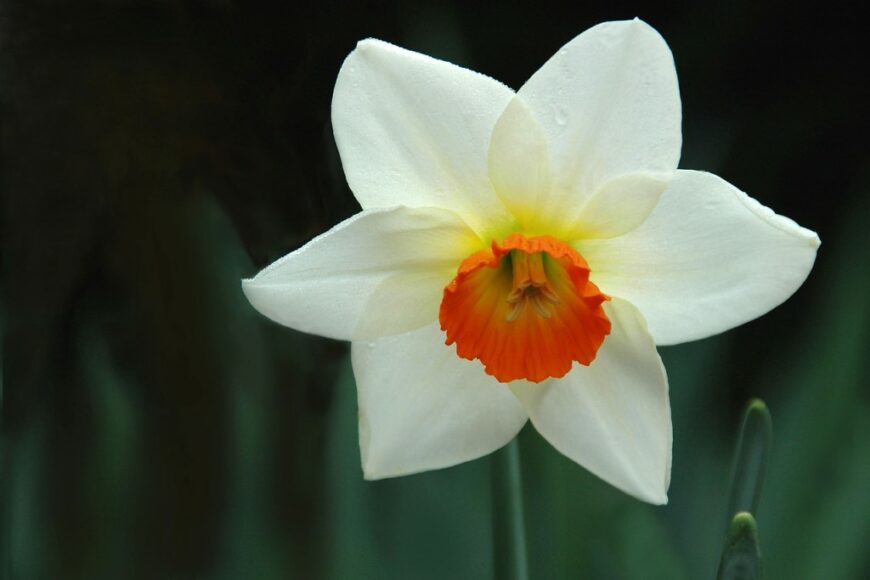
 Name: Narcissus, Common names: Daffodil, narcissus, Other names: Jonquil, paperwhite
Name: Narcissus, Common names: Daffodil, narcissus, Other names: Jonquil, paperwhite Family: Amaryllidaceae
Family: Amaryllidaceae Origins: Europe and North Africa
Origins: Europe and North Africa Humidity: Moderate to high humidity
Humidity: Moderate to high humidity Location: Full sun to partial shade
Location: Full sun to partial shade Soil: Well-drained, fertile soil
Soil: Well-drained, fertile soil Pests and diseases: Narcissus bulb fly, narcissus smudge, aphids, spider mites
Pests and diseases: Narcissus bulb fly, narcissus smudge, aphids, spider mites Care: Plant daffodil bulbs in the fall, about 6-8 weeks before the first frost. Dig a hole that is twice as wide as the bulb and 3-4 inches deep. Gently place the bulb in the hole and backfill with soil. Water thoroughly. Water daffodils regularly, especially during dry periods. Deadhead spent flowers to encourage continued blooming. Divide daffodils every 3-4 years to prevent overcrowding.
Care: Plant daffodil bulbs in the fall, about 6-8 weeks before the first frost. Dig a hole that is twice as wide as the bulb and 3-4 inches deep. Gently place the bulb in the hole and backfill with soil. Water thoroughly. Water daffodils regularly, especially during dry periods. Deadhead spent flowers to encourage continued blooming. Divide daffodils every 3-4 years to prevent overcrowding. Height of growth: 8-24 inches tall
Height of growth: 8-24 inches tall Planting in the soil: Plant daffodil bulbs in the fall, about 6-8 weeks before the first frost. Dig a hole that is twice as wide as the bulb and 3-4 inches deep. Gently place the bulb in the hole and backfill with soil. Water thoroughly.
Planting in the soil: Plant daffodil bulbs in the fall, about 6-8 weeks before the first frost. Dig a hole that is twice as wide as the bulb and 3-4 inches deep. Gently place the bulb in the hole and backfill with soil. Water thoroughly. Blooming: Daffodils bloom in late winter to early spring.
Blooming: Daffodils bloom in late winter to early spring.Narcissus, commonly known as daffodils, is a genus of perennial plants that belong to the Amaryllidaceae family. Renowned for their vibrant flowers and delicate fragrance, these plants are widely cultivated for ornamental purposes. As a botanist with 20 years of experience, I have delved deep into the world of Narcissus, and in this comprehensive guide, I will share insights into planting and caring for these enchanting blooms.
Content:
Varieties of Narcissus
Narcissus encompasses a diverse range of species and cultivars, each with unique characteristics. Some popular varieties include:
Narcissus pseudonarcissus (Wild Daffodil)
Known for its naturalizing ability, this species displays golden-yellow flowers with a distinct trumpet-shaped corona.
Narcissus poeticus (Poet’s Daffodil)
Favored for its white petals and small, red-rimmed central corona, this variety is cherished for its exquisite fragrance.
Narcissus ‘Tête-à-Tête’
A miniature daffodil, ‘Tête-à-Tête’ boasts golden-yellow flowers and is well-suited for container gardening.
Planting Guidelines
Timing and Location
Narcissus bulbs are typically planted in the fall, allowing them to establish roots before winter. Choose a well-drained location with partial to full sunlight for optimal growth.
Soil Requirements
These plants thrive in well-draining, slightly acidic to neutral soil. Adding organic matter, such as compost, enhances soil fertility and promotes healthy growth.
Planting Depth and Spacing
Plant bulbs at a depth of 4-6 inches, ensuring they are spaced about 4-6 inches apart. Adequate spacing prevents overcrowding and allows for proper air circulation.
Care and Maintenance
Watering
Narcissus prefer consistently moist soil, especially during their growing season in spring. However, they are susceptible to rot in waterlogged conditions, so well-drained soil is crucial.
Fertilization
Apply a balanced, slow-release fertilizer in early spring to support healthy growth. Avoid excessive nitrogen, as it can lead to lush foliage at the expense of flower production.
Deadheading
Remove spent flowers to redirect energy back to the bulb and encourage future blooms. Allow the foliage to wither naturally before cutting it back, as this process aids in nutrient storage.
Pest and Disease Management
While Narcissus is generally hardy, watch for pests like aphids and narcissus bulb flies. Neem oil or insecticidal soap can be effective for control. Ensure good air circulation to prevent fungal diseases.
Studies and Research
Numerous studies have explored the therapeutic potential of Narcissus extracts. Research indicates the presence of bioactive compounds with antioxidant properties, suggesting potential health benefits. However, further studies are needed to fully understand the extent of these effects.
Frequently Asked Questions (FAQ)
Can Narcissus be grown indoors?
While Narcissus can be grown indoors in containers, they require a period of cold stratification for successful blooming. Plant the bulbs outdoors for a few weeks before bringing them inside to mimic winter conditions.
Are Narcissus toxic to pets?
Yes, Narcissus contain alkaloids that can be toxic to pets if ingested. Exercise caution and keep these plants out of reach of cats and dogs.
Can Narcissus bulbs be divided?
Narcissus bulbs can be divided, but it’s generally recommended to do so only when they become overcrowded, typically every 4-5 years. Lift the bulbs after the foliage has withered, separate them, and replant.

